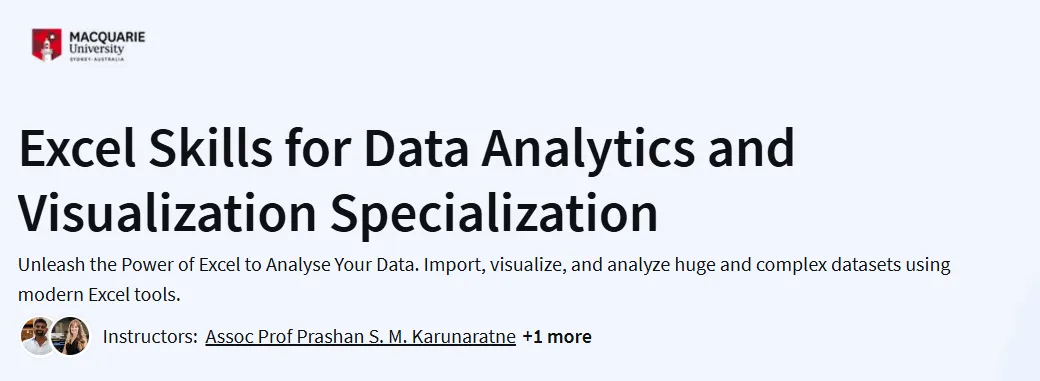What will you learn in this Excel Skills for Data Analytics and Visualization Specialization Course
Data Preparation and Cleaning: Learn to clean and prepare data using Excel functions, named ranges, and tables.
Data Visualization Techniques: Master the creation of dynamic visualizations using conditional formatting, sparklines, charts, and interactive dashboards.
Advanced Excel Tools: Gain proficiency in Power Query, Power Pivot, and DAX to handle large datasets and perform complex analyses.
Integration with Power BI: Explore the basics of Power BI to create compelling data visualizations and dashboards.
Program Overview
1. Excel Fundamentals for Data Analysis
⏳ 15 hours
Understand Excel’s interface and basic functionalities.
Learn to clean and manipulate text, numbers, and dates.
Utilize logical and lookup functions for data transformation.
Automate analysis using named ranges and tables.
2. Data Visualization in Excel
⏳ 15 hours
Create dynamic visualizations with conditional formatting and sparklines.
Develop advanced charts and custom visualizations.
Build interactive dashboards using pivot tables and slicers.
Implement macros for enhanced interactivity.
3. Excel Power Tools for Data Analysis
⏳ 15 hours
Import and transform data using Power Query.
Build data models with Power Pivot and DAX.
Visualize data using Power BI.
Automate data transformation and analysis processes.
Get certificate
Job Outlook
Proficiency in advanced Excel tools is highly sought after in roles such as Data Analyst, Business Analyst, and Financial Analyst.
Mastery of Excel’s data analysis and visualization capabilities can lead to career advancement and increased earning potential.
The integration of Excel with Power BI skills opens opportunities in business intelligence and data visualization roles.
Specification: Excel Skills for Data Analytics and Visualization Specialization
|
FAQs
- Excel can manage a wide range of analytics tasks effectively.
- It’s excellent for data cleaning, visualization, and quick insights.
- Python/R are stronger for large-scale or automated analysis.
- Many companies still rely heavily on Excel for daily operations.
- Learning Excel builds a foundation before moving to advanced tools.
- Finance and accounting rely heavily on Excel dashboards.
- Marketing teams use it for campaign tracking and reports.
- Supply chain and logistics apply Excel to manage inventory data.
- HR departments analyze workforce and payroll trends with Excel.
- Small businesses prefer Excel due to its affordability and flexibility.
- Excel works best with datasets under ~1 million rows.
- Performance slows with very large files.
- Features like Power Query and Power Pivot extend Excel’s capacity.
- For massive datasets, SQL or cloud-based tools are better.
- Good structuring and filtering prevent slowdowns.
- Excel offers a wide variety of charts and conditional formatting.
- Power BI and Tableau provide more interactive dashboards.
- Excel is faster for quick, ad-hoc reporting.
- BI tools shine with real-time data and large-scale collaboration.
- Knowing Excel makes transitioning to BI tools easier.
- Data analysts frequently use Excel for reporting.
- Business analysts rely on Excel for trend analysis.
- Financial analysts use it for forecasting and modeling.
- Operations managers use Excel dashboards for performance tracking.
- Consultants and freelancers deliver client-ready reports with Excel.





